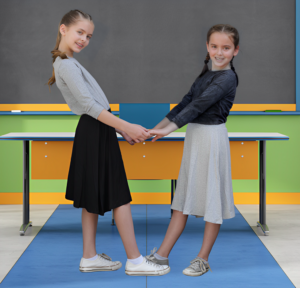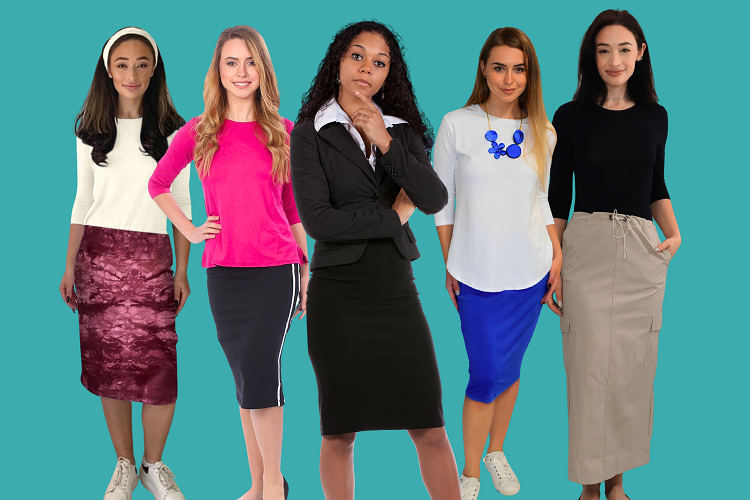
by Kosher Casual Team | Sep 18, 2024 | Dress Code, Dress Code, Girls Knee Length Skirts
Are School Dress Codes Modest?
School dress codes vary widely depending on the institution and its location, so the level of modesty can differ significantly. Dress codes are designed to maintain a sense of decorum and reduce distractions in the learning environment. Common religious school guidelines often include:
- Jewish schools might have guidelines that align with tzniut, which typically includes long skirts, sleeves covering the elbows, and avoiding see through blouses or shirts.
- Christian schools might require skirts or dresses for girls, often knee-length or longer, and may prohibit certain types of clothing like sleeveless tops, tight-fitting clothes, or anything deemed too revealing.
- Muslim schools might require hijab for girls, along with loose-fitting clothing that covers the arms and legs.
- Sometimes mandating specific types of clothing, like uniforms, which can inherently be more modest.
- Some dress codes aim for practicality and safety rather than modesty, like requiring closed-toe shoes or banning certain types of jewelry.
While these dress codes are designed to meet the standards of modesty within the school’s religious framework, opinions on what is considered “modest enough” can still vary. Some might find these dress codes perfectly aligned with their values, while others might feel they are either too strict or not strict enough, depending on their personal or community standards.
- Prohibiting clothing that reveals too much skin, such as crop tops, short shorts, and low-cut tops.
- Requiring skirts and shorts to be a certain length, usually no shorter than mid-thigh.
- Banning clothing with offensive or inappropriate graphics or language.
- Prohibited items: Some schools ban clothing with offensive language, images, or references to drugs, alcohol, or violence.

Secular School dress codes in the USA vary widely by district, school, and sometimes even by grade. While there is no standard dress code that applies to all schools, many do have policies intended to promote a level of appropriateness in the school environment. These often include parameters such as:
- No revealing clothing: This can include prohibitions on items like crop tops, short shorts, low-cut tops, and skirts or dresses that are too short (often defined as needing to be fingertip length or longer).
- No visible underwear: Students are usually required to ensure that their underwear is not visible, which means sagging pants or very low-rise jeans may be prohibited.
- Appropriate coverage: Shirts typically need to cover the midriff, and tank tops often need to have straps of a certain width (e.g., no spaghetti straps).
Challenges and Controversies
- Student Expression: Some argue that strict dress codes limit students’ ability to express their individuality.
- Fashion Trends: Fashion trends can influence how students wear their uniforms, sometimes leading to modifications that result in shorter skirts.
- Gender Disparity: Many dress codes are criticized for being more restrictive toward female students. Rules often focus on covering shoulders, legs, and cleavage, while similar restrictions aren’t always applied to male students.
School dress codes generally aim to be modest, but whether they succeed depends on cultural norms, personal beliefs and values. There is an evolving debate about what should be considered modest and how strictly school dress codes should be implemented. Using these guidelines, schools and families can create a dress code that is fair, respectful, and accommodating and strike a healthy balance between fashion and modesty.

by Kosher Casual Team | Sep 18, 2024 | Business Casual, Dress Code, Modest Business Casual, modest clothing, Modest Skirts, Uncategorized
Decoding Business Casual!
What is Business Casual? With a few simple guidelines, you can decipher your workplace’s specific dress code. Business casual setting comes with its own set of challenges, but with careful planning, you can create stylish, modest, comfortable and workplace appropriate outfits.
Observe your workplace culture. Pay attention to what colleagues and superiors are wearing. It can provide clues about the expected. Is denim acceptable? Are sweatshirts or hoodies ok? Is there a certain measure of decorum expected? The key is to find a balance that aligns with your personal style and corporate culture. If it’s unclear, consult with HR to ensure your outfits align with company expectations.
Avoid ripped fabrics or tops with slogans or words. Choose instead trendy prints, statement jewelry, scarves, or stylish handbags to add a fashionable touch to your outfit without compromising your personal style or modesty. Party or club wear, while still casual is not business casual.
Opt for skirts and dresses that fall below the knee when standing or sitting. Midi and maxi pencil or A-line skirts can be excellent choices for a business casual wardrobe. Even a sporty knee length pencil skirt with a subdued top is fine. Avoid overly tight or fitted body con clothing for a polished and professional look. If your clothing is made of sheer or semi-opaque fabric, consider pairing it with a layering tank or shell. This adds coverage while maintaining a work place suitable appearance. A lightweight, long-sleeved blouse can also be a versatile option.
Avoid low-cut or skin baring styles in general. Look for tops with crew necklines, elbow or ¾ sleeves. You can also layer with cardigans or blazers for added style and coverage. Go for soft comfortable fabrics and well-fitted pieces. Fabrics with stretch can provide both comfort and a sophisticated look.
If your workplace has casual Fridays, you can incorporate more relaxed elements, such as leggings paired with a tunic or a casual dress. Ensure that your interpretation of “casual” still aligns with a professional appearance. Don’t wear flip flops or back less sandals. Closed-toe shoes, such as flats, loafers, clean gym shoes or boots are suitable.
Remember, the key is to find a balance that aligns with your personal style, company culture, and the expectations of your workplace. Always prioritize comfort, professionalism, and modesty when assembling your business casual wardrobe.
Do you have business casual at your workplace? What is your ideal business casual outfit?

by Kosher Casual Team | Oct 25, 2017 | Dress Code, Fashion Philosophy, Modest, modest clothing
One small piece of the storm surrounding Harvey Weinstein has been a resurgence of the question of whether modest clothing prevents rape. Mayim Bialik brought the issue back to the limelight when she wrote an opinion piece for the New York Times. In it, she implied that she had never been assaulted because “I dress modestly. I don’t act flirtatiously with men as a policy.” (She later retracted that implication on Twitter.)
It shouldn’t need saying, but modest clothing doesn’t reduce sexual assault. If it did, there wouldn’t be any assaults against burka-wearing Muslim women or long-skirted and cloaked Jewish women.
Brands like ours certainly disprove Mayim’s implication that dressing modestly is less attractive. There are so many great fashion lines out there that put effort into making modest dressing women feel beautiful. Just cast an eye over the huge stable of fashion bloggers who pull together amazing outfits from the modest pieces that are in regular fashion stores.
But it’s possible that modest dressing can make a difference to sexual assault, just not the way you might think.
It’s not about the clothes.
It’s about the mindset.
Women who’ve chosen to dress modestly generally feel more self-confident. They project an aura of assertiveness, of feeling comfortable in their skin. Contrary to popular myth, modest-dressers are not just victims of patriarchal brainwashing, nor are they ashamed of their bodies or scared of being assaulted.
One example of the power of covering up comes from looking at how powerful women dress. Check out how much skin is shown by female CEOs, politicians and other important women. The more power you have, the less skin you show.
Psychologists hold that sexual assault isn’t about sex. It’s about power. Choosing to dress modestly takes back the power into women’s own hands.
Note that the key word here is choice. This fascinating video shows a Muslim woman liberated from ISIS in Raqqa ripping off the abaya she was forced to wear to reveal equally modest clothing beneath. She wasn’t objecting to wearing modest clothing; she objected to the modest clothing she was forced to wear. It’s the modest clothing we choose that empowers us.
Modest clothing sends a clear message that this woman is not a man’s plaything, eye candy or entertainment. The aura of confidence that surrounds modest dressing women might just deter a number of men who, like all bullies, feel free to cat-call, comment or grab at an easy target.

by Kosher Casual Team | Aug 20, 2017 | Dress Code, Fashion Philosophy, modest clothing, Modest Fashion
As we approach the end of the summer and the new school year, anyone with children is starting to think about all the school supplies and books they need to buy. But, in addition to the typical and necessary things children need for school, new clothing somehow always finds its way to the shopping list.
It seems as though the clothing is becoming smaller and skimpier and as such, encouraging our children, especially for school, to choose modest items is proving more difficult. Because of this, many schools are opting to establish dress codes or even uniforms. Although this seems like a great solution to a widespread problem, it actually creates many challenges for parents, students, and teachers.
The dress code, which is often the first choice, is great because it allows the school to set guidelines while maintaining the ability for students to express themselves and be unique. A dress code can encourage unity among students, greater productivity in the classroom, save time in the morning and instill a real world appropriate vs. non – concept. On the other hand, there are many challenges to implementing a dress code. The biggest problem with a dress code is the inability to enforce rules uniformly. Often teachers must make judgments based on rules that can seem unfair to students. Especially with rules like the fingertip rule (where shorts and skirts should rise no higher than the tips of one’s finger), which varies greatly based on a person height and length of their arm or legs. Leaving it up to a teacher to decide what is ‘too tight’ can even leave students feeling picked on and judged.
Overall, dress codes work to ensure that the school environment remains conducive to learning and while there may be obstacles to achieving that, it is the smallest and simplest way to maintain control.
What do you remember from dress codes when you were in school? How does that compare to the dress codes in our children’s schools today?

by Kosher Casual Team | Jul 20, 2017 | Dress Code, Fashion Philosophy, modest clothing, Modest Fashion
Women who choose to follow a religious or cultural dress code are often grappling with what defines modest dress as, well, modest. Although different cultures may vary on what is considered modest, there are certain standards that are accepted as modest dress.
Modesty is a way of life. It is about choosing to keep things private that today have been exploited. That means for some women, trying to dress modestly is about minor technicalities like covering up past their elbows and knees or concealing their ankles. However, for other women, it may mean avoiding sheer fabrics or very tight revealing clothing. The concept of modesty is an important and personal one, and therefore different opportunities to express oneself modestly should be available.
Modesty and chastity are developed from within oneself, yet expressed outwardly. People as well should dress in ways that reflect their modest choices and beliefs and refrain from outwardly judging others’ choices in dress or how their modesty is conveyed.
Have you fallen into that trap of judging others for not being modest enough? Or bending the standards of modest dress? Share how you personalize the experience of modest dress below, I’d love to hear from all of you.

by Kosher Casual Team | Jul 4, 2017 | Dress Code, Fashion Philosophy, Kosher Casual, Modest, modest clothing, Modest Fashion
It seems there are many misconceptions about women who choose to dress modestly. Especially with fashion trends implying that modest clothing is simply that, a trend. Of course, women are and have always been under scrutiny for showing too much skin or not showing enough skin, which goes to show that women cannot escape the natural tendency for men and strangers to judge a woman’s dress.
Often dressing preferences are dictated by mood, weather or even a lack of clean laundry! Recently there are more and more women favoring clothing and designs that are considered modest, baggy sweaters, long maxi skirts and those Peter Pan collared button ups. Many of these trends became popular simply because designers were lacking a plunging neckline in their lines.
Feminism has taken the brunt of the blame when it comes to emerging modest trends although it’s easy to prove that fashion has had moments of modest influence almost every few decades. Feminists are feminists because of the need and outstanding lack of equality that exists for women who work or play as hard as men. Dressing modestly, therefore, would have nothing to do with Feminism and rather be a choice made by women to empower themselves. Actively disobeying some unspoken rule about how women should dress or behave is likely the last reason a woman would choose to dress immodestly.
What drives you to dress modestly? Share below in the comments.








